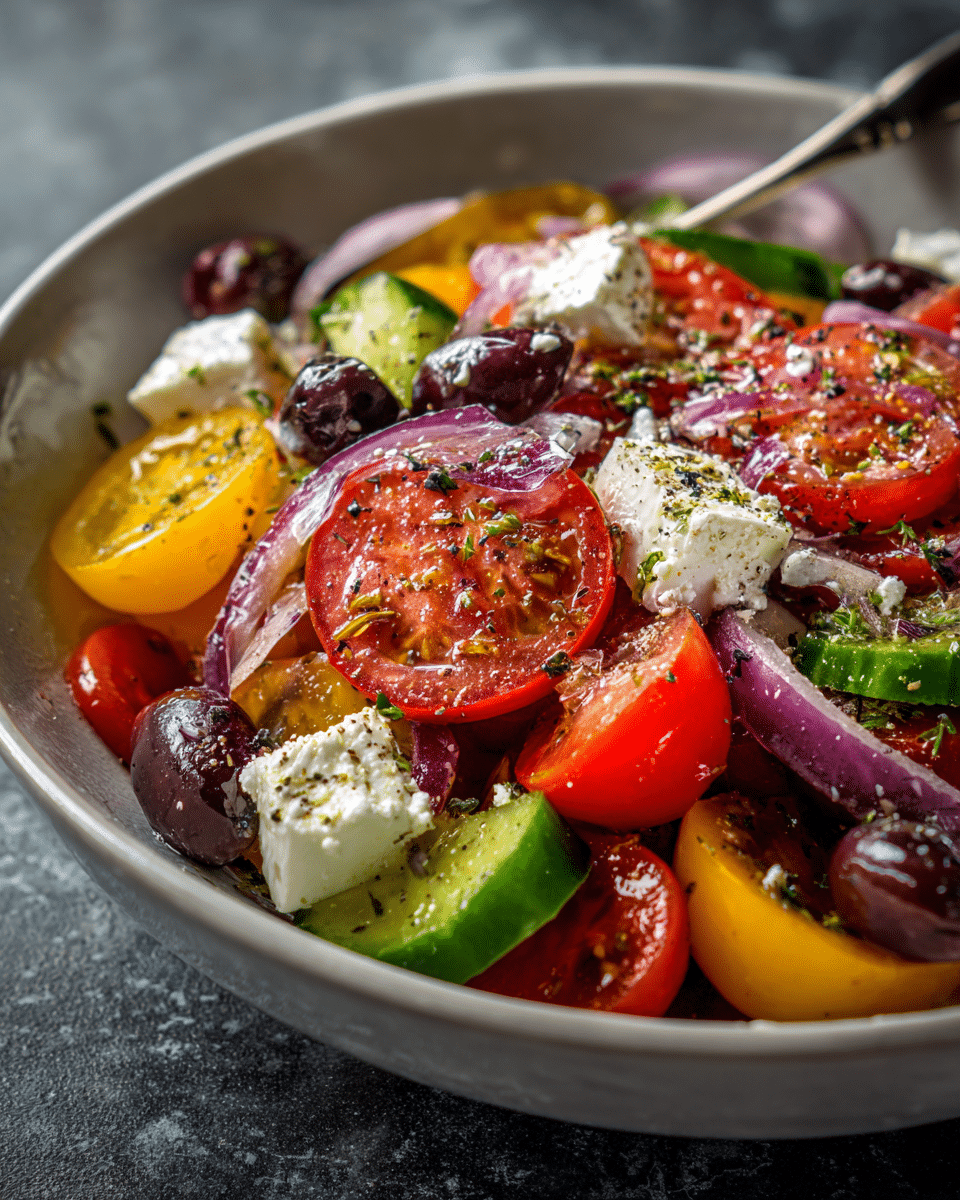The Labor Day Ultimate Greek Salad is a vibrant, refreshing dish that celebrates the fresh flavors of the Mediterranean. Bursting with ripe tomatoes, crisp cucumbers, briny olives, and creamy feta cheese, this salad offers the perfect balance of tangy, savory, and fresh notes. Drizzled with a zesty olive oil and red wine vinegar dressing, it’s a colorful side that pairs beautifully with grilled meats, seafood, or plant-based entrées making it an ideal choice for festive summer gatherings.
FULL RECIPE
Ingredients
- 4 large ripe tomatoes, chopped into bite-sized pieces
- 1 large cucumber, peeled and sliced into half-moons
- 1 red onion, thinly sliced
- 1 green bell pepper, sliced into thin strips
- 1 cup Kalamata olives, pitted
- 1 cup feta cheese, cut into small cubes or crumbled
- ¼ cup extra-virgin olive oil
- 2 tablespoons red wine vinegar
- 1 teaspoon dried oregano
- ½ teaspoon sea salt (or to taste)
- ½ teaspoon freshly ground black pepper
- Fresh parsley, chopped (optional, for garnish)
Directions
- In a large salad bowl, combine the chopped tomatoes, cucumber slices, red onion, green bell pepper, and olives.
- Gently toss the vegetables together to evenly distribute the colors and textures.
- Add the feta cheese on top, either crumbled or cubed, depending on your preference.
- In a small bowl, whisk together the olive oil, red wine vinegar, oregano, salt, and black pepper until fully emulsified.
- Pour the dressing over the salad and toss gently to coat all ingredients evenly without breaking up the feta too much.
- Taste and adjust the seasoning with additional salt or pepper if needed.
- Garnish with fresh parsley if desired, and serve immediately for the freshest flavor.
Nutrition Facts
- Calories: 190
- Total Fat: 15g
- Saturated Fat: 5g
- Cholesterol: 20mg
- Sodium: 590mg
- Total Carbohydrates: 9g
- Dietary Fiber: 2g
- Sugars: 5g
- Protein: 5g
- Vitamin A: 20% DV
- Vitamin C: 45% DV
- Calcium: 15% DV
- Iron: 6% DV
The Mediterranean Essence of Greek Salad
Greek salad captures the heart of Mediterranean cuisine with its reliance on fresh, seasonal produce and simple, high-quality ingredients. The combination of crisp vegetables, briny olives, and creamy feta creates a harmonious balance of flavors that is both satisfying and refreshing. It’s a dish that celebrates the natural beauty of food, relying on minimal seasoning so that each ingredient can shine. Its versatility makes it perfect for anything from a casual summer picnic to an elegant dinner party, and it embodies the spirit of gathering and sharing that Mediterranean culture is known for.
Nutritional Benefits
One of the greatest advantages of Greek salad is its impressive nutritional profile. Fresh tomatoes are rich in lycopene, an antioxidant known for its heart health benefits, while cucumbers provide hydration and vitamin K. The olives and olive oil contribute heart-healthy monounsaturated fats, which can help reduce inflammation and support cardiovascular function. Feta cheese, though moderate in calories, offers calcium and protein, supporting bone health and muscle maintenance. Together, these ingredients create a nutrient-dense dish that can be part of a balanced diet while still feeling indulgent and flavorful.
The Role of Olive Oil and Vinegar
The dressing in a Greek salad is as important as the vegetables themselves. High-quality extra virgin olive oil brings a fruity richness that complements the briny olives and tangy feta, while also delivering healthy fats. Red wine vinegar adds brightness and acidity, cutting through the creaminess of the cheese and balancing the salad’s flavors. This simple yet effective pairing highlights the Mediterranean approach to dressings—minimal but impactful, enhancing the natural taste of the ingredients without overpowering them.
Texture and Flavor Balance
A well-prepared Greek salad offers a delightful interplay of textures and flavors. The tomatoes bring juicy sweetness, the cucumbers offer a refreshing crunch, and the onions contribute a sharp bite. The olives add saltiness, while the feta provides a creamy, slightly tangy counterpoint. Each bite offers a balanced mix of these elements, ensuring the salad is never boring. The key lies in proportion—no single ingredient should dominate, allowing the harmony of flavors to define the dish.
Popular Variations
While the traditional Greek salad is beloved worldwide, there are countless ways to adapt it to suit personal tastes or seasonal availability. Some people add avocado for creaminess, chickpeas for extra protein, or roasted red peppers for a smoky sweetness. Fresh herbs like mint or dill can bring new dimensions to the flavor profile. In coastal areas, grilled shrimp or calamari is sometimes added, transforming the salad into a seafood-focused meal. Even the cheese can vary—halloumi or goat cheese can be used in place of feta for a different texture and taste.
Serving Suggestions
Greek salad is remarkably versatile when it comes to serving options. It can stand alone as a light lunch, be served as a side dish alongside grilled meats or fish, or act as a starter for a multi-course meal. For a more substantial dish, it can be paired with warm pita bread, hummus, or tzatziki. At large gatherings, serving it in a big bowl family-style encourages guests to help themselves, fostering a relaxed and communal atmosphere that’s perfect for celebrations.
Pairing with Other Dishes
The fresh, zesty flavors of Greek salad make it a natural partner for a wide variety of foods. It pairs beautifully with grilled lamb chops, baked salmon, or chicken souvlaki. For vegetarian meals, it complements roasted vegetable platters, stuffed grape leaves, and falafel. In summer, pairing it with chilled soups like gazpacho or watermelon soup can create a refreshing menu. Its acidity and freshness also make it an excellent side for rich dishes, as it cuts through heavier flavors and cleanses the palate.
Storage and Make-Ahead Tips
Greek salad is best enjoyed fresh, but it can be made partially in advance to save time. The vegetables can be chopped and stored separately in airtight containers in the refrigerator for up to a day. The dressing can also be prepared ahead of time and kept in a jar. To maintain the salad’s texture, avoid adding the dressing and feta until just before serving. Leftovers can be refrigerated for up to a day, but the vegetables may release moisture and soften over time, so it’s best to store any undressed salad for the freshest taste.
Seasonal Ingredient Swaps
Although Greek salad has a traditional set of ingredients, seasonal substitutions can keep it exciting year-round. In summer, heirloom tomatoes and fresh basil can enhance the flavor, while in cooler months, roasted root vegetables can add warmth and heartiness. Baby spinach or arugula can be added for extra greens, and different types of olives, such as Castelvetrano or green Cerignola, can introduce new flavor notes. These swaps keep the salad aligned with seasonal produce availability while maintaining its Mediterranean spirit.
Advertisement
Cultural Significance
Greek salad, or “Horiatiki,” is a staple in Greek cuisine and culture. Traditionally served without lettuce, it reflects the rustic cooking style of rural Greece, where meals are built from locally grown vegetables, olives from nearby groves, and cheese from regional dairies. The dish is as much about community and tradition as it is about flavor it’s often shared at family tables and in tavernas, symbolizing hospitality and the joy of eating together. Including it in a Labor Day celebration brings a touch of Mediterranean tradition to an American holiday, merging cultures through food.
Conclusion
The Labor Day Ultimate Greek Salad is more than just a colorful side it’s a celebration of freshness, balance, and cultural heritage. Its health benefits, adaptability, and bold yet harmonious flavors make it an enduring favorite for gatherings large and small. Whether enjoyed as part of a casual backyard barbecue or a festive holiday feast, this salad delivers on taste, nutrition, and visual appeal.






